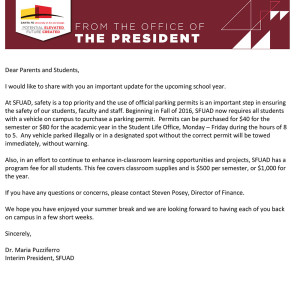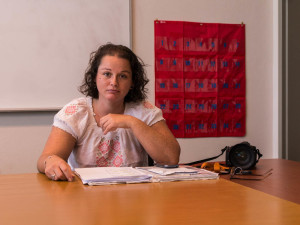Tags
Related Posts
Share This
New Year, New Fees

Interim President Maria Puzziferro notified students of SFUAD’s new program fee via e-mail on Aug. 11.
Students at SFUAD received a surprise in the weeks leading up to the Fall 2016 semester: a $1,000 program fee added to their accounts (the fee is split into two charges of $500 per semester). Some stumbled across the fee while preparing their finances for the approaching school year. Others heard of the fee for the first time when they received an email from Interim President Maria Puzziferro on Aug. 11, less than three weeks before classes began. Puzziferro directed further questions on the fee increase to Director of Finance Steven Posey.
Posey says the decision to implement the fee began as part of the budget process in late 2015, even though students did not receive notice until just before the semester began. He admits the administration “did a poor job on that communication and says it should have been sent in May.”
Posey also provided more specific details in an e-mail to Jackalope: “The program fee was implemented for the 2016-2017 academic year to offset increasing costs related to content delivery, all of which aim to enhance the learning experience for our students. Examples of those costs are fabrics to create costumes, wood/paint to create sets, shop supplies/tools and props/licenses to produce shows, toner, chemicals and chemical disposal and art labs, writing/digital labs (hardware and software). Included in the costs of the labs are student workers and access to Adobe Creative Cloud.”
Students won’t necessarily see expensive new equipment popping up in their respective departments.
“There’s a new printer in the digital arts lab that just went in,” Posey says. “We had to buy all new inks, all new toner for that. So some departments, there will be something that will be seen immediately, and other departments, we’re just trying to cover rising costs.”
Nonetheless, students and their parents struggled to make adjustments for the additional financial burden given the short notice. Junior Film major Airon “Air” Malone already works two jobs, one at the Driscoll Fitness Center and another recruiting students for Engage Santa Fe, an organization that helps high school dropouts earn their diplomas. He had to take on a third job at Panera Bread in order accommodate the additional program fee.
“I said I would never go back to fucking fast food,” Malone says. “But I’ve got to do what I’ve got to do, so I’m going to work two days a week at Panera, about eight hours a day.”

Senior Photography major Sasha Hill going over new program fee billing. Photo by Yoana Medrano.
Senior Photography major Sasha Hill lives off of $630 a month from disability insurance. As a Navy veteran, the U.S. Department of Veterans Affairs pays her tuition, but she says that didn’t cover the new program fee. She paid the $1,000 up front at the beginning of the semester, which required a few sacrifices.
“I lost my cable,” Hill says. “I don’t get any cable. I don’t get any Internet. I don’t get any home phone, which I rely on a lot, because that’s how I get my Wi-Fi so I’m able to check my emails and do my work and send in my homework.” She couldn’t pay her care insurance or her electricity bill, either.
Senior Graphic Design major Julian Williams says he’s had to finance the last two years of his schooling himself.
“This last year of school, my junior year, I paid it just with graphic design work,” Williams tells Jackalope. “But I have to pay for my food, my rent and my school, and so an extra $1,000 a year is a big deal to me. … I’m considering taking on another part-time job on top of my freelance work just to cover everything.”
Creative Writing major Todd Harris suggests that it would have been helpful for Puzziferro to hold an open forum so students could ask questions and understand the reasons for the charges. Instead, “we just showed up here the first day of school and it felt like nothing happened,” Harris says. “It brought the morale down.”
The responsibility for issuing a notice to students typically falls to the school’s Operations Support department, but in May 2016, Director of Student Operations Melissa Rudd left SFUAD, leaving the position vacant.
“Melissa was leaving, Christine [Guevara] was coming,” Posey says. “I would say that it was overlooked during the transition.”
It became clear while generating student bills in the last week of July that an official statement should be made.
“We review the bills before they’re generated and sent to students and we realized that we had not communicated the program fee,” Posey says.
The $500 charge per semester is an average based on a model created by the school’s leadership team (which consists of Posey, Puzziferro, Interim Provost Debra Tervala and the Student Life and Marketing departments).
“We looked at the way the costs had been increasing, and increasing not necessarily with regard to enrollment increases, but just the cost of providing certain things for the programs to be run,” Posey says. “So $500 seemed to be the average number that came out that would support the departments as a whole. Some departments are bigger. Film is obviously bigger than Creative Writing or Photography.”
As the Film department enrolls a higher number of students, there are more funds to keep their program running. Though the cost of running the department is higher than others, their high enrollment numbers offset the department’s expenses.
Posey says he received around 25 e-mails regarding the new fee, and only a couple of phone calls.
“It seemed to be more on the Facebook page that students were venting about the fee,” Posey says. “There are some who want to try to continue to link the fee to other items not related to education.”
Some students requested a breakdown of the school’s budget, but as a private company, SFUAD is under no obligation to make those details available.
“I don’t think every student wants to know everything [the program fee] is spent on. I think they want an understanding of what that fee is for and what it’s providing for their program,” Posey says. “I understand that it seems to have come out of left field. It wasn’t explained well. In addition to being right before term started, we didn’t explain what the fee was for. We just said ‘classroom supplies.’ That’s not what it’s for. It’s for program costs. Some departments, that’s a little more obvious. Visual Arts, Film, those are a little obvious as to what they’re getting for that. Creative Writing, Photography, Performing Arts, those are a little less clear, so we should have communicated earlier and we should have had a more detailed communication.”






 Jackalope Magazine is the student magazine of Santa Fe University of Art and Design. Building on the interdisciplinary nature of our education, we aim to showcase the talent of our university and character of our city.
Jackalope Magazine is the student magazine of Santa Fe University of Art and Design. Building on the interdisciplinary nature of our education, we aim to showcase the talent of our university and character of our city.
Recent Comments